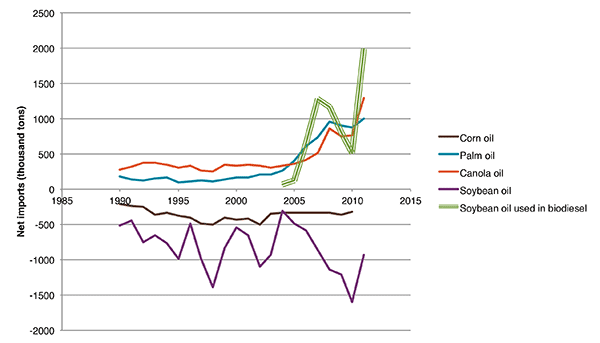Blog
Is the Renewable Fuel Standard inadvertently driving up U.S. palm oil imports?
If you’re reading this on your lunch break, take a look at the ingredients label on your cookies. Chances are you’ll see one or a combination of soybean oil, palm oil, and canola oil, perhaps partially hydrogenated. Can you tell the difference between a Chips Ahoy chocolate chip cookie that’s made with soybean oil and one that’s made with palm (as I’ve seen on different ingredients labels)? I can’t. And I bet that when Nabisco switches ingredients based on price, it counts on the majority of consumers not telling the difference either.
In the United States, a lot of food is made with soybean oil, sometimes labeled generically as “vegetable oil.” The U.S. is the world’s largest producer of soybeans, and its oil is used in a lot of food products, and increasingly in biodiesel. The Renewable Fuel Standard (RFS) required 1.28 billion gallons of biodiesel to be blended into diesel fuel in the U.S. last year, over half of which was made from soybean oil. That’s a lot—almost one-third of all soybean oil produced in the U.S.! Soybean oil that’s going into biodiesel is soybean oil we’re not eating anymore, but this doesn’t mean America has gone on a diet. Prices of other vegetable oils tend to be similar, or even in some cases cheaper, and because most consumers can’t tell the difference, food manufacturers have been switching to other types of oil. Confirming this, you can see in the chart below that net imports of palm and canola oils have increased dramatically as more soybean oil has been diverted to biodiesel over the last few years. A big dip in soy biodiesel production was accompanied by a rise in soy oil exports in 2010 as the market readjusted to the end of ‘splash and dash’ (a tax loophole in which U.S. biodiesel was exported to the EU to received a second incentive) but the overall trend has been for biodiesel production to increase, and imports of other vegetable oils to increase alongside it.

This market substitution between soybean oil and palm oil in the U.S. has now been demonstrated in a statistical analysis by Yin Qiu. In a master’s thesis written with support from ICCT, Qiu showed that the cross-price elasticity of palm oil imports to soybean oil price in the U.S. is 3.22 – this means that a 1% increase in the price of soybean oil drives an approximately 3% increase in palm oil imports. (Qiu performed a regression analysis using the price of whole soybeans as an instrumental variable to allow this causal effect to be determined.) According to the theory of supply and demand, as supply of U.S. soybean oil for food consumption declines (more of it diverted for biodiesel) and demand remains constant, the price of soybean oil should increase. As the price increases, food product manufacturers like Nabisco and other soybean oil consumers switch to a slightly cheaper substitute like palm oil – and Qiu’s analysis shows they switch very readily. This ensures that the prices of different vegetable oils track each other closely, and allows palm and canola to fill in the soybean oil gap left by the biodiesel mandate. So while palm oil biodiesel does not (currently) qualify under the RFS, the U.S. biofuels mandate still drives increased consumption of palm oil.
Does it matter what kind of vegetable oil we’re eating? Besides having possible health implications, it can matter a lot in terms the environment and climate change. Most palm oil in the world is produced in Indonesia and Malaysia, where tropical forests are regularly cleared to grow more oil palm. We’ve shown that one-third of new oil palm plantations replace rainforest on peat soil. In addition to hosting endangered orang-utans, tropical peat forests contain enormous amounts of stored carbon—oxidizing this soil to establish oil palms causes the release of 95 tonnes CO2e per hectare per year when annualized over a 30 year timeframe. This level of land use change emissions likely has a substantial effect on the lifecycle greenhouse gas mitigation potential of soybean biodiesel in the U.S., but may have been underestimated in previous ILUC modeling. Having a better estimate available of the elasticity of substitution between these different vegetable oils should allow new modeling work to better account for this effect.
